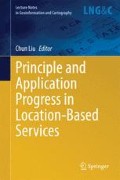Abstract
Compared to vehicle trajectories that are solely generated from outdoor environments, most pedestrian GPS trajectories are recorded in mixed indoor and outdoor environments. Due to the problems of poor indoor accuracy and sparseness of signal points, processing of indoor GPS trajectories is significantly different from that of outdoor GPS data. Existing research often assumes that GPS signal is completely missing in indoor environments. However, with the sensitive GPS receivers and some big windows, satellite signals can also be picked up in indoor environments. To address the above problem, this chapter presents a signal-loss-based method to segment and analyze mixed indoor/outdoor pedestrian GPS trajectories. Firstly, by considering the signal-loss periods in indoor environments, a clustering method is proposed to segment indoor/outdoor sub-trajectories from each trajectory. Based on that, the approach for understanding trajectory patterns is developed, which uses features such as speed, distance and time to recognize “passing” pattern and “indoor activity” pattern in indoor environments, as well as “move-stop” pattern, “more-move” pattern and “more-stop” pattern in outdoor environments. Finally, we evaluate the proposed method with some real trajectories to study its feasibility in segmenting and analyzing mixed indoor/outdoor pedestrian GPS trajectories.
Access this chapter
Tax calculation will be finalised at checkout
Purchases are for personal use only
References
Alvares LO, Bogorny V, Kuijpers B, de Macedo JAF, Moelans B, Vaisman A (2007). A model for enriching trajectories with semantic geographical information. Paper presented at the 15th annual ACM international symposium on Advances in geographic information systems, ACM, New York, USA, pp 22:1–22:8
Alvarez A, Alonso JM, Trivino G (2013) Human activity recognition in indoor environments by means of fusing information extracted from intensity of WiFi signal and accelerations. Inf Sci 233(1):162–182
Andrienko N, Andrienko G (2006) Exploratory analysis of spatial and temporal data: a systematic approach. Springer. ISBN 978-3-540-25994-7
Ashman KM, Bird CM, Zepf SE (1994) Detecting bimodality in astronomical datasets. Astron J 108:2348–2361
Buchmueller S, Weidmann U (2006) Parameters of pedestrians, pedestrian traffic and walking facilities. ETH Zurich, Ivt Report no. 132
Giannotti F, Pedreschi D (2008) Mobility, data mining and privacy: geographic knowledge discovery. Springer. ISBN 978-3-540-75176-2
Idrissov A (2012) A data cleaning framework for trajectory clustering. MSc Thesis, University of Alberta, Canada
Kalliola K (2008) Bringing navigation indoors—the way we live next 2008, Nokia, 23 Sept 2008
Millonig A, Gartner G (2010) Show me my way: the use of human spatio–temporal behaviour patterns for developing ubiquitous way finding systems. In: Wachowicz M (ed) Movement-aware applications for sustainable mobility: technologies and approaches (Chapter 10), IGI Global, Hershey, pp 157–174
Moore DS (2010) The basic practice of statistics. W.H. Freeman and Company. ISBN 978-1-42922-426-0
Motte H, Wyffels J, De Strycker L, Goemaere JP (2011) Evaluating GPS data in indoor environments. Adv Electr Comput Eng 11(3):25–28
Mountain D, Raper JF (2001) Modelling human spatio-temporal behaviour: a challenge for location-based services. Paper presented at the 6th international conference on geocomputation, Brisbane, Australia, 24–26 Sept 2001
Palma AT, Bogorny V, Kuijpers B, Alvares LO (2008) A clustering-based approach for discovering interesting places in trajectories. Paper presented at the 2008 ACM symposium on Applied computing, pp 863–868. ACM, New York, NY, USA
Parent C, Spaccapietra S, Renso C, Andrienko G, Andrienko N, Bogorny V, Damiani ML, Gkoulalas-divanis A, Macedo J, Pelekis N, Theodoridis Y, Yan Z (2013) Semantic trajectories modeling and analysis. ACM Comput Surv 45(4):1–37
Renso C, Spaccapietra S, Zimányi E (2013) Mobility data: modeling, management, and understanding. Cambridge University Press, Cambridge, UK
Rocha J, Oliveira G, Alvares L, Bogorny V, Times V (2010) Db-SMOT: a direction-based spatio-temporal clustering method. Paper presented at the 5th IEEE international conference of. intelligent systems, University of Westminster, London, UK, pp 114–119
Schüssler N, Axhausen KW (2008) Processing GPS raw data without additional information. Eidgenössische Technische Hochschule, Institut für Verkehrsplanung und Transportsysteme
Spaccapietra S, Parent C, Damiani ML, Macedo JA, Porto F, Vangenot C (2008) A conceptual view on trajectories. Data Knowl Eng 65:126–146
Spinsanti L, Celli F, Renso C (2010) Where you stop is who you are: understanding peoples’ activities. Paper presented at the 5th BMI, workshop on behaviour monitoring and interpretation 2010, Karlsruhe, Germany
Tsui SYA, Shalaby AS (2006) An enhanced system for link and mode identification for GPS-based personal travel surveys. Trans Res Rec: J Trans Res Board 1972:38–45
UCSD (2011) Personal activity location measurement system: users guide—San Diego: center for wireless & population health systems (CWPHS), University of California San Diego (UCSD)
Wachowicz M (2010) Movement-aware applications for sustainable mobility: technologies and approaches. IGI Global. ISBN 978-1-61520-769-5:1-338
Xie K, Deng K, Zhou X (2009) From trajectories to activities: a spatio-temporal join approach. Paper presented at the 2009 international workshop on location based social networks. ACM, New York, USA, pp 25–32
Yan Z, Chakraborty D, Misra A, Jeung H, Aberer K (2012) Semantic activity classification using locomotive signatures from mobile phones—EPFL-REPORT-174016, Ecole Polytechnique Federale de Lausanne
Yan Z, Chakraborty D, Parent C, Spaccapietra S, Aberer K (2013) Semantic trajectories: mobility data computation and annotation. ACM Trans Intell Syst Technol 4(3):49:1–49:38
Zheng Y, Zhou X (2011) Computing with spatial trajectories. Springer. ISBN 978-1-4614-1628-9
Acknowledgments
We would like to thank prof. dr. ir. S.C. van der Spek from Department of Urbanism in Delft University of Technology for sharing the urban dataset (“tracking Delft I: walking patterns in the city centre”). We also thank the anonymous reviewers and the editor for their constructive comments.
Author information
Authors and Affiliations
Corresponding author
Editor information
Editors and Affiliations
Rights and permissions
Copyright information
© 2014 Springer International Publishing Switzerland
About this chapter
Cite this chapter
Cao, Y., Huang, H., Gartner, G. (2014). A Signal-Loss-Based Clustering Method for Segmenting and Analyzing Mixed Indoor/Outdoor Pedestrian GPS Trajectories. In: Liu, C. (eds) Principle and Application Progress in Location-Based Services. Lecture Notes in Geoinformation and Cartography. Springer, Cham. https://doi.org/10.1007/978-3-319-04028-8_1
Download citation
DOI: https://doi.org/10.1007/978-3-319-04028-8_1
Published:
Publisher Name: Springer, Cham
Print ISBN: 978-3-319-04027-1
Online ISBN: 978-3-319-04028-8
eBook Packages: Earth and Environmental ScienceEarth and Environmental Science (R0)

